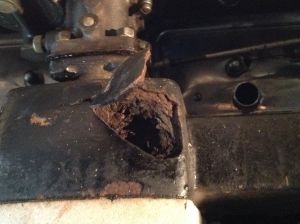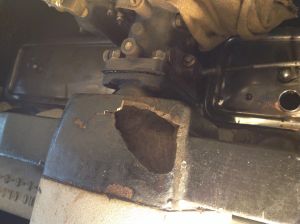- Home
- About Us
- Join/Renew
- Member Benefits
- Member Pages
- Log In
- Help
- Museum Store
I recently discovered a bulged out section on the intake manifold of our 1930 model B just above the carburetor. On old brazed repair split, allowing a section of the manifold side to bend out. This section of the manifold is part of the manifold heater system and is connected to the exhaust manifold, and not open to the intake passage, so it has not affected the running of the engine. Evidently, rust from the exhaust manifold collected on the bottom of this chamber surrounding the intake passage, expanded with moisture from the exhaust, and has broken out a section as shown in the photo. So far, it does not leak exhaust. My heater valve is evenintly rusted shut enough to prevent that, which is OK with me. This is probably not an uncommon failure with these manifolds, and my question is, what repair procedure have other drivers used to temporarily solve this problem? My local Pierce Arrow dealer assures me that new manifolds have been on back order for the past 80 years, but should be here any day now.
My intent is to v cut around the perimeter on the piece now that everything is cleaned out, and use JB Weld high temp to glue it back into place. Before doing so, thought I’d check with the experts for other suggestions. I am reluctant to use heat to rebraze the repair.
Another photo will follow.
Tom Barrett

Second photo. Don’t know why every photo I send to PAS comes out upside down. Sorry.
Tom

I have a few thoughts.
First, if you’re going to put a patch it, I would think you’d cut a new piece of metal to the shape of the hole, then if JB Weld is an option, use that to secure the new piece. One thing about JB is that the metal needs to be super clean so it adheres, so you’d have to really put the cleaning power to the edge of the hole. Wire brush or otherwise, best would be bead blast but that’s not possible on the car.
The other issue is you have cracks radiating out from the hole, and these will continue to grow. At minimum, drill a small hole at the end of each crack, and fill it with JB or something else. This will at least stop the crack from growing.
I’m sure there are other’s who will chime in who’ve had more experience with this. There are also skilled craftsman out there who could heat this up and put in a welded patch, but then you have other issues.
If I were you I’d also start looking for another manifold, if this one has such a large issue at that spot, you can figure that it may have other issues, too, that just aren’t visible at this time.
Maybe this will be useful.
I have no idea, but Studebaker did own P-A for a while.
http://www.castironrepair.com/projects
These guys have done a few jobs for me and the quality has been outstanding. Most recently was my ‘32 exhaust manifold.
That Studebaker manifold set is correct for ’29 only. The Pierce design was changed in late ’29 and was used on the 1930 cars before changing again for ’31.
It was changed prior to Nov of ’29 because my car has the ’30 manifold.
My car was manufactured in late Nov. of ’29.
Does anyone know when the change occurred?
Well, I thought it was worth a shot!
Maybe some 1929 Pierce-Arrow person will have interest.
In reference to the manifold change on the 1929 Pierce Arrows: My very low mileage Roadster #2005776 which I believe to be a September 1929 car according to numbers listed in an Arrow from years back.My car still has the McKeelite headlamp lenses with the bulbs being dipped by resistance and the typical 1929 manifold arrangement but my car has the battery on the driver’s side and the AirMaze type air filter on the UU2 carburetor.I believe the lamp and manifold change took place in October of 1929 and the change may be noted in the 133-143 parts book depending on when it was printed.There were a number of running changes.The Studebaker manifold while looking similar is different and the manifold on Ebay looks different from the one on my car or other 1929’s with the typical 133-143 manifold assemblies.One would want to check dimensions and it is possible the whole assembly if all matched could keep a car on the road.This issue with the intake is interesting as the problems have always been with the exhaust manifolds due to expansion and contraction.There should be a good 1930 intake out there somewhere.A good cast iron person could as a last resort I believe perform a repair on this intake.
